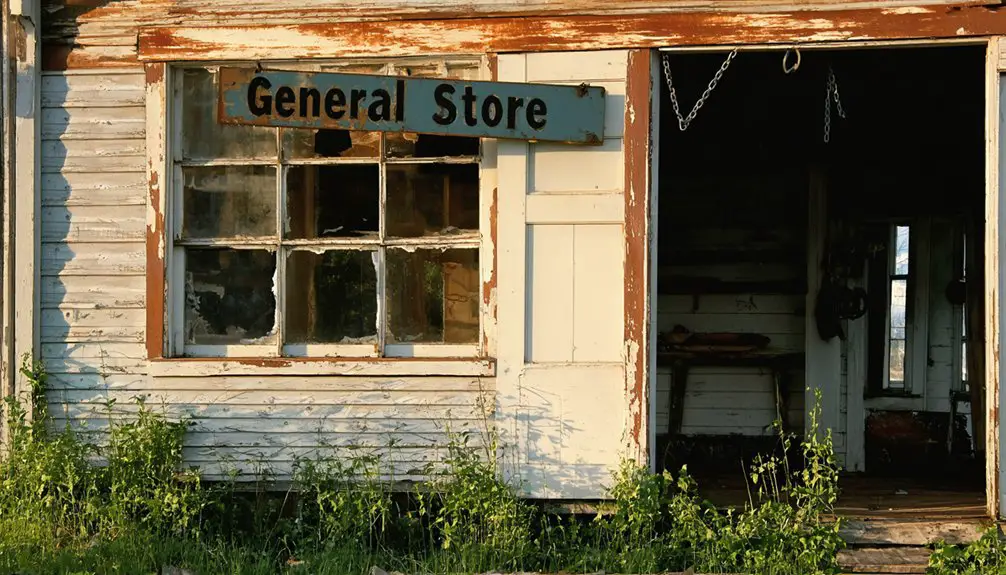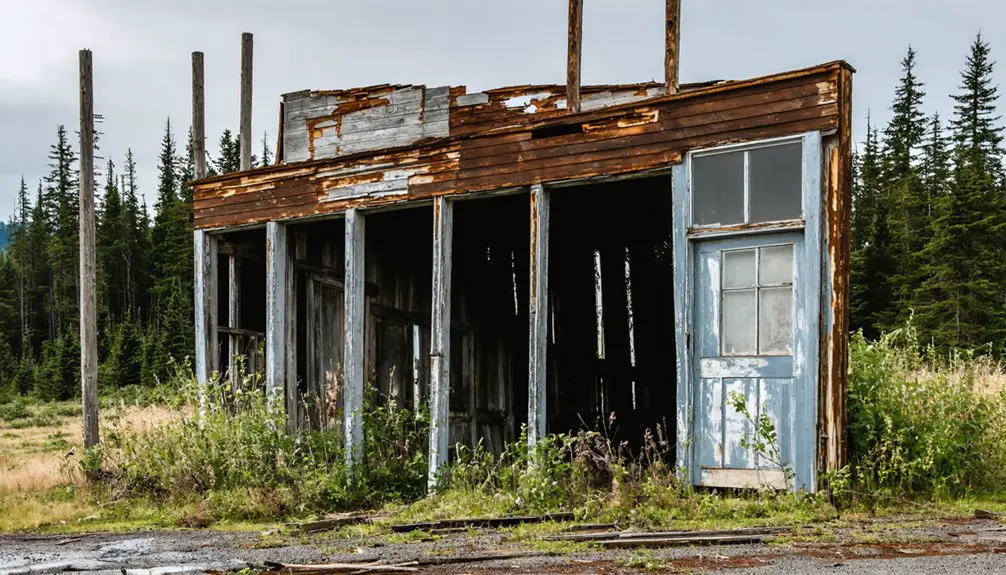You’ll find Corbett’s weathered remains in Cleveland County, Oklahoma, where J.P. Corbett established this farming community on 80 acres in 1893. Originally named “Higgy,” the town thrived on agriculture until the Great Depression‘s devastating impact, when plummeting crop prices forced many residents to abandon their homes. Today, the iconic Baptist church steeple still stands among scattered buildings, telling a compelling story of boom-and-bust cycles in Oklahoma Territory’s post-Reconstruction era.
Key Takeaways
- Corbett was established in 1893 on 80 acres in Cleveland County, Oklahoma Territory, originally named “Higgy” due to local influences.
- The town’s Baptist Church, with its 1880s steeple, served as the community center and remains a prominent architectural landmark.
- Economic collapse during the Great Depression, with plummeting farm prices and mass unemployment, led to the town’s eventual abandonment.
- Several well-maintained homes and buildings still stand, offering visitors glimpses into late 19th-century frontier architecture and rural life.
- Corbett is among Oklahoma’s 2,000 ghost towns, attracting history enthusiasts while facing preservation challenges from natural deterioration and vandalism.
The Rise of Corbett: A Late 19th Century Settlement
While many Oklahoma settlements emerged from the chaotic land runs of the 1890s, Corbett’s founding took a more methodical approach. In 1893, J.P. Corbett carefully selected 80 acres of fertile land and meticulously planned the town’s layout to support agricultural practices.
Originally known as “Higgy” due to local Higby family influences, the settlement patterns reflected a desire for orderly development rather than the rushed expansion seen in other frontier towns. Despite early optimism, the town never achieved city status due to poor quality farmland.
You’ll find that Corbett’s establishment aligned with Oklahoma Territory’s post-Reconstruction period, when small farming communities were taking root across the region. Today, the town’s history is preserved through local podcasts that share stories of its past.
Unlike the rowdy boomtowns of the era, Corbett emerged as a peaceful agricultural village, designed to serve local farmers with essential services while maintaining a quiet, rural character that would define its identity.
Life in Early Corbett: Community and Culture
As life took root in early Corbett, the town’s social fabric centered around its modest church, which stood as the heart of community gatherings until the 1930s.
The remote location and weather conditions made the settlement vulnerable to natural disasters, similar to nearby Burke City which was abandoned after devastating floods. You’d find a close-knit population living a self-sufficient lifestyle typical of rural Oklahoma, where agricultural practices defined daily routines and seasonal rhythms. Similar to many other ghost town settlements, the community’s peak activity occurred during the post-statehood period when natural resources were first discovered.
The town’s spirit came alive through:
Small town life flourished through community gatherings, where neighbors forged lasting bonds and created cherished memories together.
- Church services and faith-based activities that brought families together
- Seasonal farming events that united neighbors during planting and harvest
- Community dances and social gatherings that offered respite from daily labor
- Local food production through farming and hunting, supplemented by traveling merchants
Life wasn’t always easy in this remote settlement, but residents maintained strong social bonds through shared activities and mutual support, creating a resilient community culture that defined Corbett’s early years.
Economic Forces That Shaped the Town
Throughout Corbett’s tumultuous history, the town’s economic destiny followed the volatile patterns common to many Oklahoma settlements of its era.
You’ll find that oil boom activities in the region likely sparked periods of rapid growth, bringing waves of workers and speculators to the area. Like many Oklahoma towns, Corbett’s survival heavily depended on railroad connections, which determined whether goods and people could easily reach the community. Similar to Beer City’s rise during its heyday, the town thrived on lawless frontier activities.
The decaying crumbling buildings and signs scattered throughout the town stand as silent witnesses to its former prosperity. As larger economic forces reshaped the region, Corbett faced the harsh realities of modernization. Agricultural changes reduced farming jobs, while urbanization pulled residents toward bigger cities.
If Corbett had relied on temporary boom industries like oil or questionable enterprises like the liquor trade, these activities’ eventual decline would’ve hastened the town’s abandonment.
The Great Depression’s Impact on Corbett
When the Great Depression struck in the 1930s, Corbett’s agricultural foundation crumbled under catastrophic price collapses. Dust pneumonia threatened residents’ health as intense dust storms ravaged the region.
You’d have witnessed cotton prices plummet from 16 to 6 cents per pound, while wheat crashed from $1 to just 38 cents per bushel. The agricultural decline hit local farmers hard, with farm income plunging 64%.
The devastating impact led to severe migration challenges, as struggling families faced:
The harsh realities of Depression-era life forced countless families to uproot, seeking survival amid unprecedented hardship and uncertainty.
- Loss of tenant farming opportunities as mechanization took over
- Environmental pressures from drought and dust storms
- Widespread unemployment and poverty
- Limited relief options from overwhelmed local charities
You’d have seen many of your neighbors join the estimated 100,000 Oklahomans who fled west to California and Arizona, earning the label “Okies” and facing hostility in their desperate search for work. With unemployment reaching critical levels, over 300,000 urban workers found themselves without jobs during the winter of 1932-33.
Architectural Legacy and Standing Structures
Despite the town’s decline, Corbett’s architectural heritage endures through several notable structures, with the Baptist Church’s 1880s steeple standing as its most prominent landmark.
Unlike many Oklahoma ghost towns, you’ll find several well-maintained homes still occupied today, reflecting the region’s rural aesthetics and pioneer-era construction methods. The church and surrounding residences showcase typical late 19th-century wooden architecture common in Oklahoma Territory settlements. Some buildings remain standing but are in neglected sites with visible rubble and deteriorating conditions.
While architectural preservation remains informal, the peaceful countryside setting has helped protect these historic buildings. You won’t find the extensive ruins or abandoned structures typical of other ghost towns here. Many of these structures are in better condition than those in toxic ghost towns like Picher, where environmental contamination accelerated decay.
Instead, Corbett’s remaining buildings, though limited in number, offer glimpses into the community’s frontier past, with the church steeple serving as a lasting symbol of its architectural legacy.
Historical Significance in Cleveland County
Corbett’s roots in Cleveland County trace back to J.P. Corbett‘s meticulous planning of an 80-acre agricultural village in 1893, just four years after the dramatic Land Run of 1889.
The town’s establishment reflects the cultural heritage of Cleveland County’s transformation from Native American territory to organized settlement.
- The area’s historical landmarks included the Cross Timbers and Colonel Chouteau’s trading post near Lexington.
- Corbett emerged during a pivotal period when Cleveland County was organizing its government under Oklahoma Territory.
- The town’s agricultural focus aligned with the county’s early economic drivers of farming and horse breeding.
You’ll find Corbett’s story intertwined with the county’s broader development, influenced by President Cleveland’s namesake county and the establishment of Norman as the county seat.
Ghost Town Tourism and Preservation Efforts

Today, Oklahoma’s ghost towns like Corbett stand among nearly 2,000 abandoned settlements across the state, drawing history enthusiasts and adventure seekers to their weathered remains.
You’ll find ghost town preservation efforts facing significant challenges, from natural deterioration to vandalism, while limited funding restricts restoration possibilities.
Despite these obstacles, you can support local historical societies and volunteer groups working to document and protect these cultural treasures.
When you visit, you’re contributing to the economic importance of surrounding communities through tourism spending, which helps fund preservation initiatives.
While many ghost towns struggle with maintenance and protection, your interest in exploring these historic sites helps raise awareness about their significance and encourages broader community support for their preservation.
Lessons From Oklahoma’s Lost Communities
Oklahoma’s ghost towns offer powerful lessons about community survival and decline.
You’ll find that these lost communities reveal important insights about the fragile nature of settlement sustainability and community resilience in the face of changing economic conditions and environmental challenges.
- When towns rely too heavily on single industries like mining or oil, they’re vulnerable to devastating boom-bust cycles.
- Natural resource depletion and environmental negligence, as seen in Picher’s toxic legacy, can destroy entire communities.
- Railroad access and transportation networks prove essential for long-term survival.
- Urban migration patterns show how changing demographics and economic opportunities can rapidly transform rural areas.
These lessons aren’t just historical curiosities – they’re crucial reminders of how communities must diversify and adapt to survive in an ever-changing landscape.
Frequently Asked Questions
Are There Any Documented Paranormal Activities or Ghost Sightings in Corbett?
Despite your enthusiasm to uncover spooky secrets, you won’t find any documented ghost stories or paranormal evidence here. The town’s truly haunting feature is its profound silence and abandonment.
What Happened to the Original Residents After Leaving Corbett?
After leaving Corbett, you’d find the residents scattered across Cleveland County and nearby towns, with many taking jobs in oil fields, railroads, and growing urban centers while others resettled on rural homesteads.
Was the Town Cemetery Preserved, and Where Were Residents Typically Buried?
As quiet as whispers in time, your ancestors’ cemetery lacks formal preservation programs. Residents were typically buried in the Corbett Cemetery or nearby family plots, following rural Oklahoma’s traditional burial practices.
Did Any Notable Crimes or Significant Legal Disputes Occur in Corbett?
You won’t find documented historical crimes or legal disputes in Corbett’s records. Unlike other Oklahoma ghost towns known for controversies, this community’s history reflects a peaceful decline without notable criminal incidents.
Are Metal Detecting or Artifact Collecting Activities Permitted at the Site?
You’re walking on thin ice if you try metal detecting or artifact collecting here without permits. You’ll need proper authorization for public lands and written permission for private property.
References
- https://en.wikipedia.org/wiki/List_of_ghost_towns_in_Oklahoma
- https://www.okhistory.org/publications/enc/entry?entry=GH002
- https://www.loquis.com/en/loquis/6762301/Corbett+Oklahoma
- https://kids.kiddle.co/List_of_ghost_towns_in_Oklahoma
- https://www.youtube.com/watch?v=XF_KokeSwjk
- https://www.wikiwand.com/en/articles/List_of_ghost_towns_in_Oklahoma
- https://okmag.com/blog/a-ghostly-site/
- https://beerconnoisseur.com/articles/infamous-wild-west-ghost-town-beer-city-oklahoma/
- http://www.ou.edu/news/articles/2024/may/ou-researcher-unveils-book-of-oklahomas-ghost-towns.html
- https://www.gearyschools.org/vimages/shared/vnews/stories/522f9e3953516/Chapter 13 How did people in Oklahoma deal with the Great Depression.pdf



